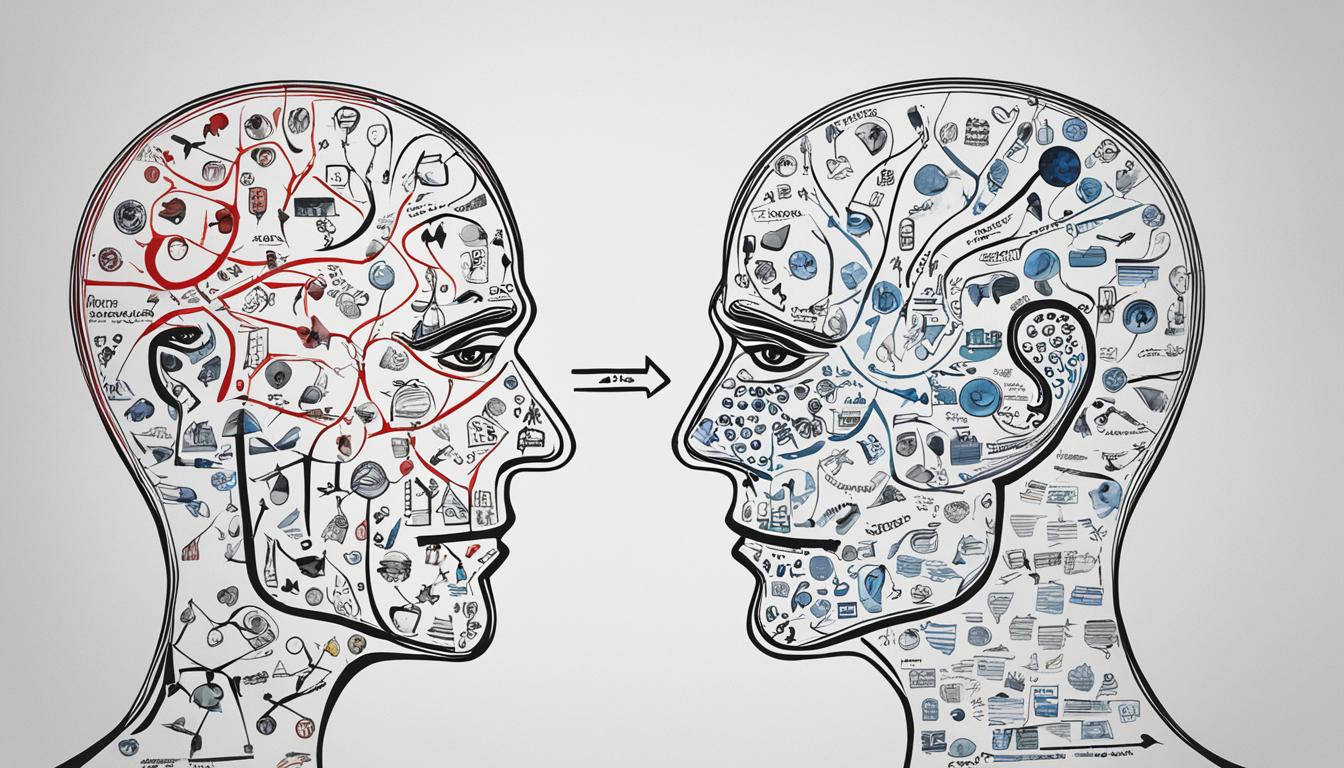Did you know that nearly 40% of individuals diagnosed with Borderline Personality Disorder (BPD) also exhibit symptoms that align with Narcissistic Personality Disorder (NPD)? This interesting statistic underscores the significant overlap between these two personality disorders, which complicates both diagnosis and treatment. Recognizing the comorbidity of BPD and NPD is essential for mental health professionals and individuals dealing with these co-occurring disorders.
Key Takeaways:
- BPD and NPD frequently co-occur in individuals, with approximately 40% having symptoms of both disorders.
- Diagnosing and treating the overlap of BPD and NPD can be challenging due to the complex nature of these personality disorders.
- Understanding the similarities and differences between BPD and NPD is essential for developing appropriate treatment approaches.
- The overlap of BPD and NPD can have a significant impact on relationships and overall functioning.
- Caretakers of individuals with BPD and NPD should prioritize self-care and seek professional help to navigate the challenges associated with these disorders.
Understanding Borderline Personality Disorder (BPD)
Borderline personality disorder (BPD) is a Cluster B personality disorder characterized by consistent changes in behavior, mood, and self-image. Individuals with BPD often experience episodes of anger, depression, and anxiety. Their opinions of themselves and others, as well as their interests, may drastically change, leading to tumultuous or unstable relationships.
Dissociation is also common in individuals with BPD, where they may feel detached from their emotions, memories, and thoughts. Mental health professionals diagnose BPD using specific criteria outlined in the Diagnostic and Statistical Manual of Mental Disorders (DSM-5).
Treatment approaches for BPD may include psychotherapy, medication, and other therapeutic interventions tailored to the individual’s needs, as determined through psychological assessment.
Diagnostic Criteria for Borderline Personality Disorder (BPD)
- Frantic efforts to avoid real or imagined abandonment
- A pattern of unstable and intense interpersonal relationships alternating between idealization and devaluation
- Impulsivity in at least two areas that are self-damaging (e.g., spending, substance abuse, reckless driving)
- Recurrent suicidal behavior, gestures, or threats, or self-mutilating behavior
- Affective instability due to a marked reactivity of mood
- Chronic feelings of emptiness
- Inappropriate, intense anger or difficulty controlling anger
- Transient, stress-related paranoid ideation or severe dissociative symptoms
Treatment Approaches for Borderline Personality Disorder (BPD)
- Psychotherapy: Dialectical behavior therapy (DBT), mentalization-based therapy, and schema-focused therapy are commonly used approaches in treating BPD. These therapies aim to enhance emotional regulation, improve interpersonal skills, and promote self-awareness and identity development.
- Medication: Certain medications, such as antidepressants, mood stabilizers, and antipsychotics, may be prescribed to manage specific symptoms associated with BPD, such as depression, impulsivity, or distorted thinking patterns. However, medication alone is typically not considered a primary treatment for BPD.
- Other Therapeutic Interventions: Additional therapeutic interventions, such as group therapy, family therapy, and art therapy, can complement the core treatment approaches for BPD. These interventions provide further support, promote social connections, and offer creative outlets for self-expression.
“Psychotherapy, medication, and other therapeutic interventions tailored to the individual’s needs play a crucial role in the treatment of Borderline Personality Disorder (BPD). With the right support and treatment, individuals with BPD can learn to manage their symptoms, improve their relationships, and lead fulfilling lives.” – Mental Health Professional
Understanding the diagnostic criteria and available treatment approaches for BPD is essential for both individuals affected by the disorder and mental health professionals providing care. By utilizing psychological assessment and implementing comprehensive treatment plans, we can effectively address the challenges associated with BPD and support individuals on their journey towards improved mental health and well-being.
Understanding Narcissistic Personality Disorder (NPD)
In this section, we will delve into the intricate details of narcissistic personality disorder (NPD) and explore its diagnostic criteria, treatment approaches, therapeutic interventions, and the roles of mental health professionals in managing this condition. NPD falls under Cluster B personality disorders and is characterized by several distinct traits:
- Sense of entitlement: People with NPD believe they deserve special treatment and privileges.
- Inflated self-importance: They have an exaggerated sense of their own significance and achievements.
- Arrogance and haughty behavior: Individuals with NPD often display a condescending attitude towards others.
- Lack of empathy: They have difficulty understanding and relating to other people’s emotions.
- Preoccupation with fantasies of success and admiration: Those with NPD daydream about limitless success and crave constant admiration.
A formal diagnosis of NPD is based on specific criteria outlined in the Diagnostic and Statistical Manual of Mental Disorders (DSM-5). While there are currently no empirically supported treatments specifically tailored for NPD, certain approaches used for borderline personality disorder (BPD) have shown promise. For instance, dialectical behavior therapy (DBT) and schema-focused therapy can be effective in addressing some of the symptoms associated with NPD.
“Individuals with NPD may be resistant to treatment due to their poor insight into their behaviors and a lack of motivation to change. However, with the right therapeutic interventions, positive outcomes can still be achieved.”
It is crucial for mental health professionals to conduct thorough psychological assessments and provide appropriate interventions to support individuals with NPD on their journey toward better mental well-being. Despite the challenges associated with treating NPD, empathy and a tailored treatment approach can make a significant difference in an individual’s overall quality of life.

Diagnostic Criteria for Narcissistic Personality Disorder (DSM-5)
| Criterion | Description |
|---|---|
| Grandiosity | Exaggerated sense of self-importance and achievements |
| Attention-seeking behavior | A constant need for admiration and attention from others |
| Lack of empathy | Difficulty understanding and relating to other people’s emotions |
| Exploitation | Tendency to take advantage of others for personal gain |
| Arrogance | Displaying a haughty and disdainful attitude towards others |
The Overlap Between BPD and NPD
The co-occurrence of borderline personality disorder (BPD) and narcissistic personality disorder (NPD) is a topic of interest in clinical practice. Research suggests that approximately 39% to 40% of individuals with BPD also meet the criteria for NPD. This overlap presents unique challenges in diagnosis and treatment.
While there are similarities between BPD and NPD, such as dramatic thinking and behaviors, there are also significant differences that distinguish the two disorders. Individuals with NPD tend to display egotistical behavior and a lack of empathy, whereas those with BPD may experience anger turned inward and frequent changes in behavior and mood.
Therefore, mental health professionals use clinical perspectives to assess the overlap between BPD and NPD and develop appropriate treatment approaches and therapeutic interventions. Understanding the co-occurrence and its implications in clinical practice is crucial for providing comprehensive care to individuals with both disorders.
Differentiating BPD and NPD
While BPD and NPD share some common features, they have distinct characteristics that can help differentiate between the two:
| BPD | NPD |
|---|---|
| Emotional instability and fear of abandonment | Egotistical behavior and lack of empathy |
| Frequent changes in behavior and mood | Grandiosity and need for admiration |
| Impulsive and self-destructive behaviors | Exploitative tendencies and sense of entitlement |
By recognizing these differences, mental health professionals can accurately diagnose BPD and NPD, enabling them to implement appropriate and effective treatment strategies.
The Comorbidity of BPD and NPD
The co-occurrence of BPD and NPD presents unique challenges in clinical practice. Individuals with both disorders may exhibit more severe symptoms and have a higher risk of comorbid conditions. The comorbidity of BPD and NPD requires a comprehensive evaluation to ensure comprehensive treatment.
Treatment Approaches and Therapeutic Interventions
When treating individuals with comorbid BPD and NPD, mental health professionals must consider the specific needs and challenges associated with both disorders. Treatment approaches and therapeutic interventions that address the core features of BPD, such as dialectical behavior therapy (DBT) and mentalization-based therapy, may also be effective for individuals with comorbid BPD and NPD.
Therapeutic interventions in these cases aim to help individuals develop healthier coping mechanisms, improve emotional regulation, and foster more meaningful relationships. It is crucial to tailor the treatment to the individual’s unique needs and address both BPD and NPD symptoms to achieve successful long-term outcomes.

In Summary
The co-occurrence of BPD and NPD presents challenges in diagnosis and treatment. Although there are similarities between the two disorders, recognizing their differences is vital in providing appropriate care. Mental health professionals employ clinical perspectives to assess the overlap and develop treatment approaches and therapeutic interventions that address the unique needs of individuals with both BPD and NPD.
In the next section, we will explore the impact of the overlap between BPD and NPD on relationships and functioning, shedding light on the challenges faced by individuals and their loved ones.
Impact on Relationships and Functioning
The overlap between individuals with Borderline Personality Disorder (BPD) and Narcissistic Personality Disorder (NPD) can have a significant impact on their relationships and overall functioning. Both disorders are characterized by distinct symptoms that can create challenges in interpersonal dynamics.
People with BPD often struggle with emotional dysregulation, leading to impulsive behaviors, intense mood swings, and fears of abandonment. These individuals may experience difficulties in maintaining stable and healthy relationships, often exhibiting dysfunctional behaviors that can strain their interactions with others.
On the other hand, individuals with NPD have a pervasive pattern of grandiosity, a lack of empathy, and an intense need for admiration. These characteristics can contribute to difficulties in forming genuine connections, as their focus is primarily on seeking validation and attention from others.
When BPD and NPD coexist, the challenges become compounded. The chaotic emotional life of BPD can clash with the self-centeredness and lack of empathy seen in NPD, resulting in destructive patterns and manipulation within relationships.
“The overlap of BPD and NPD can create a toxic cocktail that can harm not only the individuals themselves but also those around them.”
Mental health professionals who diagnose and treat individuals with both BPD and NPD must consider the impact of the overlap on relationships. Understanding the symptoms and dynamics of both disorders is essential in developing effective treatment strategies.
Impact on Relationships
The combined features of BPD and NPD can lead to the following challenges in relationships:
- Intense interpersonal conflicts and difficulties in maintaining long-term relationships.
- Frequent emotional outbursts and unpredictable mood swings.
- Manipulative and controlling behaviors, often driven by a need for validation.
- A lack of empathy and an inability to understand or meet the emotional needs of others.
- A pattern of idealizing others initially and then devaluing them abruptly.
These challenges can strain relationships and create a cycle of dysfunction, as individuals with these overlapping disorders struggle to establish healthy and balanced connections with others.
Impact on Functioning
The impact on functioning extends beyond relationships, affecting various aspects of individuals’ lives:
- Difficulties in maintaining stable employment due to impulsive behaviors or conflicts with superiors and colleagues.
- Challenges in managing emotions, leading to disruptions in daily activities and responsibilities.
- Struggles with decision-making, often oscillating between extreme choices or being indecisive.
- Feelings of emptiness, identity confusion, and a lack of stability in personal goals and aspirations.
Overall, the overlap of BPD and NPD can substantially impact both relationships and overall functioning, making it imperative for mental health professionals to address these challenges in the diagnosis and treatment process.

Comparison of BPD and NPD Symptoms
| Borderline Personality Disorder (BPD) | Narcissistic Personality Disorder (NPD) |
|---|---|
| Intense fear of abandonment | Grandiose sense of self-importance |
| Unstable and intense relationships | Lack of empathy |
| Impulsive and self-destructive behaviors | Constant need for admiration |
| Emotional dysregulation and mood swings | Exploitative behavior |
| Identity disturbance and chronic feelings of emptiness | Arrogant and haughty behavior |
The Challenge of Treatment
Treating individuals with comorbid BPD and NPD can be quite challenging. The complexity of these personality disorders poses unique obstacles in providing effective treatment. People with NPD often lack insight into their condition and may resist seeking help or making changes. The distress they cause is more often directed towards others, resulting in a lack of motivation to modify their behavior. Unfortunately, no specific treatments for NPD currently exist, and treatment options for comorbid BPD and NPD are still being explored. However, certain therapies designed for BPD, such as dialectical behavior therapy and mentalization-based therapy, show promise in addressing some of the symptoms and challenges associated with both disorders.

“Treating individuals with comorbid BPD and NPD can be challenging due to the complexity of these personality disorders.”
Long-Term Outlook
When it comes to individuals with both Borderline Personality Disorder (BPD) and Narcissistic Personality Disorder (NPD), research suggests a potentially gloomier long-term prognosis compared to those with only one of the disorders. Studies have shown that rates of NPD co-occurrence are higher in individuals whose BPD symptoms do not improve over time. This combination of BPD and NPD can lead to ongoing difficulties in relationships and emotional instability.
Unfortunately, the long-term effects of comorbid BPD and NPD are still being explored, and more research is needed to fully understand their interplay. It is clear, however, that treatment outcomes for individuals with this overlapping diagnosis are complex and multifaceted. Treatment approaches that prove effective for either BPD or NPD alone may not be as successful when both disorders are present simultaneously.
As mental health professionals continue to grapple with the intricacies of treating comorbid BPD and NPD, it is crucial to remain committed to finding effective therapeutic interventions that can address the long-term effects and prognosis. By investing in further research and understanding, we can shed light on this overlapping condition and provide better support for individuals navigating the challenges of BPD and NPD together.
| Long-Term Outlook | Key Points |
|---|---|
| BPD and NPD Prognosis | The prognosis for individuals with both BPD and NPD may be poorer compared to those with only one of the disorders. Further research is needed to fully understand the long-term effects and prognosis. |
| Long-Term Effects and Challenges | The combination of BPD and NPD can lead to ongoing difficulties in relationships and emotional instability. |
| Treatment Outcomes | Currently, treatment outcomes for individuals with comorbid BPD and NPD are still being explored. It is important for mental health professionals to use tailored interventions in order to address the complexity of this overlapping diagnosis. |

“The prognosis for individuals with both BPD and NPD may be poorer compared to those with only one of the disorders.”
Focus on Self-Care for Caretakers
Caretakers of individuals with BPD and NPD often face significant challenges in their own lives. As caretakers, it is essential for us to prioritize our own well-being through self-care strategies. Taking care of ourselves allows us to better support and care for our loved ones.
Setting boundaries is crucial in ensuring we maintain our own mental health and prevent burnout. It is important to establish limits on our time, energy, and emotional investment to avoid becoming overwhelmed. By prioritizing our own needs, we can ensure we have the capacity to provide the care and support our loved ones require.
Building a support system is another vital aspect of self-care for caretakers. Connecting with other caretakers who are facing similar challenges can provide a sense of understanding, validation, and guidance. Online communities, support groups, and forums can offer a platform for us to share experiences, seek advice, and find solace in knowing we are not alone.
Seeking professional help is beneficial for both ourselves and our loved ones. Therapy or counseling can provide us with the tools and coping strategies needed to navigate the challenges associated with the overlap of BPD and NPD. Mental health professionals can offer guidance, support, and a safe space for us to address our own emotions and experiences as caretakers.
In addition to seeking professional help, practicing self-care activities is crucial for our mental well-being. Engaging in hobbies, pursuing personal interests, or simply taking time for ourselves can help us recharge and maintain a healthy mindset. By prioritizing self-care, we can better manage stress, reduce caregiver fatigue, and find moments of joy amidst the challenges.
Remember, taking care of ourselves is not selfish; it is necessary. By prioritizing self-care, setting boundaries, building a support system, and seeking professional help, we can ensure that we remain strong, healthy, and capable of providing the support our loved ones need.
| Coping Strategies for Caretakers |
|---|
| Set boundaries and prioritize your needs. |
| Build a support system with other caretakers. |
| Seek professional help through therapy or counseling. |
| Engage in self-care activities, such as hobbies or personal interests. |

Seeking Professional Help
When dealing with the challenges associated with the overlap of BPD and NPD, seeking professional help is crucial. Mental health professionals, such as therapists or counselors, play a vital role in guiding individuals affected by these disorders towards better understanding and support. They possess the expertise to provide tailored guidance, support, and therapeutic interventions to address the unique needs of each individual.
Therapy and Counseling: Mental health professionals offer various forms of therapy and counseling to help individuals navigate the complexities of BPD and NPD. Through these sessions, individuals have a safe space to explore their experiences, emotions, and challenges. Therapists and counselors can help individuals gain insight, develop coping strategies, and work towards personal growth and healing.
Diagnosis and Treatment: Seeking professional help is essential for an accurate diagnosis and effective treatment plan. Mental health professionals can conduct comprehensive assessments and evaluations to identify BPD and NPD symptoms, determine the extent of overlap, and establish a personalized treatment approach. With their expertise, they can help individuals implement the appropriate strategies and interventions to manage their symptoms and improve their overall well-being.
Caregiver Support: Mental health professionals are also valuable resources for caregivers of individuals with BPD and NPD. They can provide guidance, resources, and coping strategies to help caregivers navigate the challenges and complexities associated with these disorders. Professional support can assist caregivers in establishing boundaries, managing their own well-being, and maintaining healthy relationships.
“Seeking professional help is essential for individuals affected by the overlap of BPD and NPD. Mental health professionals provide guidance, support, and therapeutic interventions tailored to the individual’s needs.”
Remember, professional help is available to assist individuals with BPD, NPD, and their caretakers on their journey towards improved mental health and well-being. Whether it’s therapy, counseling, or comprehensive diagnostic assessments, mental health professionals offer the expertise and support necessary to navigate the challenges associated with the overlap of these personality disorders.

Supportive Resources
When dealing with the challenges posed by the overlap of BPD and NPD, it’s important to know that there are supportive resources available to help individuals affected by these conditions. These resources can play a crucial role in providing guidance, support, and a sense of community for those navigating the complexities of BPD and NPD.
Online communities, support groups, and forums are excellent platforms for individuals to connect with others facing similar challenges. These communities provide a safe and understanding space where individuals can share their experiences, seek advice, and find support from people who truly understand the unique difficulties posed by these personality disorders.
Books and self-help resources can offer valuable insights and strategies for individuals seeking to navigate relationships with BPD and NPD. One highly recommended resource is “Stop Caretaking the Borderline or Narcissist” by Margalis Fjelstad. This book explores practical techniques and provides tools for establishing boundaries, managing emotions, and promoting healthy relationships. It serves as a valuable companion for individuals looking to engage in self-care and personal growth.
Additionally, seeking professional help from mental health professionals, therapists, or counselors is vital for individuals affected by the overlap of BPD and NPD. These professionals can offer individualized guidance, support, and therapeutic interventions tailored to the specific needs of each individual. They provide a safe and confidential space for individuals to explore their experiences, emotions, and challenges, aiding in the diagnosis and treatment of these complex disorders.
| Support Resources | Description |
|---|---|
| Online Communities, Support Groups, and Forums | Connect with others facing similar challenges, share experiences, seek advice, and find support. |
| Stop Caretaking the Borderline or Narcissist” by Margalis Fjelstad | Explore practical techniques, establish boundaries, manage emotions, and promote healthy relationships. |
| Mental Health Professionals, Therapists, or Counselors | Receive personalized guidance, support, and therapeutic interventions tailored to individual needs. |
Conclusion
The overlap of borderline personality disorder (BPD) and narcissistic personality disorder (NPD) presents clinical perspectives that shed light on the challenges and complexities of these personality disorders. The coexistence of BPD and NPD can exacerbate symptoms and pose difficulties in diagnosis and treatment.
However, there is hope. Treatment approaches and therapeutic interventions can be customized to meet the unique needs of individuals with BPD and NPD. Mental health professionals play a crucial role in providing guidance, support, and tailored therapies to help individuals navigate the challenges that arise from this overlap.
Caretakers of individuals with BPD and NPD also have a significant impact. By prioritizing self-care, setting boundaries, and seeking support, caretakers can better manage the demands of caring for someone with these personality disorders, while also maintaining their own well-being.
Understanding, support, and self-care are key in helping individuals affected by the overlap of BPD and NPD improve their mental health and relationships. By working together, we can navigate these challenges and strive for a better future.
FAQ
What is the overlap between borderline personality disorder (BPD) and narcissistic personality disorder (NPD)?
The overlap refers to individuals who exhibit symptoms of both BPD and NPD. Approximately 40% of individuals with BPD may also have NPD, leading to signs of narcissism in these individuals.
How are BPD and NPD diagnosed?
BPD and NPD are diagnosed based on specific criteria outlined in the Diagnostic and Statistical Manual of Mental Disorders (DSM-5), which is used by mental health professionals for assessment and diagnosis.
What are the treatment approaches for BPD and NPD?
Treatment for both disorders may involve psychotherapy, medication, and other therapeutic interventions tailored to the individual’s needs. Approaches such as dialectical behavior therapy (DBT) and schema-focused therapy may be effective for individuals with both BPD and NPD.
How do BPD and NPD impact relationships and functioning?
The overlap of BPD and NPD can lead to difficulties in interpersonal relationships, dysfunctional behaviors, and challenges in functioning due to symptoms associated with both disorders.
What are the challenges in treating individuals with comorbid BPD and NPD?
Treating individuals with both disorders can be challenging due to poor insight, resistance to treatment, and the complexity of the disorders. Currently, there are no specific treatments for NPD.
What is the long-term outlook for individuals with comorbid BPD and NPD?
Research suggests that individuals with both disorders may have a poorer long-term prognosis compared to those with only one of the disorders, and understanding the long-term effects and treatment outcomes is an ongoing area of research.
How can caretakers practice self-care when supporting individuals with BPD and NPD?
Caretakers should prioritize their own needs, set boundaries, seek support, practice self-care activities, and consider seeking therapy or counseling to cope with the challenges associated with supporting individuals with BPD and NPD.
Where can individuals affected by the overlap of BPD and NPD find supportive resources?
Online communities, support groups, forums, books, and self-help resources provide platforms for individuals to connect, share experiences, and find support from others facing similar challenges.
Where can individuals affected by the overlap of BPD and NPD seek professional help?
Mental health professionals, such as therapists or counselors, can provide guidance, support, and therapeutic interventions tailored to the needs of individuals affected by the overlap of BPD and NPD.









